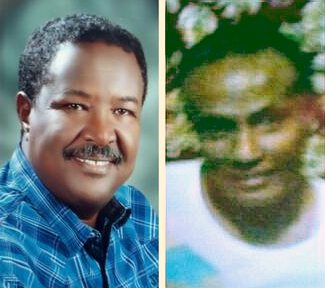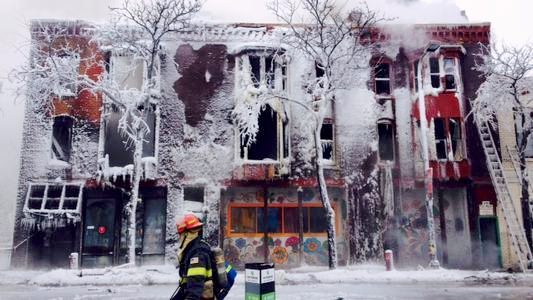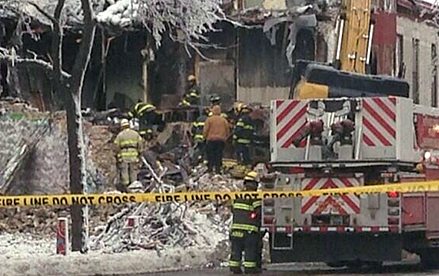Somalis in America attacking medical workers andthrowing rocks at a homosexual.
More on Somali Muslims at the bottom of the post.
From Gates of Vienna:
Let’s stand back and consider what has been learned over the past few days about what happened on that fiery New Year’s dawn in “Little Mogadishu”.
The fire chief warned the public that the cause of the explosion and fire would not be know for weeks, if it is ever known at all. He said it would take a long time for investigators to analyze the evidence.
Yet the bulk of the evidence was backhoed into a heap of rubble within 72 hours after the explosion occurred.
The fire chief also told us that the evidence (where? who saw it?) points to a natural gas leak as the most likely cause of the explosion. He said that “witnesses” had reported a smell of natural gas before the building went up.
There are only two witnesses from the scene who have been quoted on the record about the smell of gas. According to the Strib, both of them state that there was no gas smell:
Neither [Hersi] Hassan nor [Abdi] Qobey smelled gas that morning, nor did they hear any fire alarms.
This contradicts the words of the fire chief, who repeatedly emphasized a natural gas leak as the likely cause — but not before the Department of Homeland Security arrived at the scene of the fire on Thursday morning.
According to WCCO-TV:
Fire Chief John Fruetel said Thursday that investigators are focusing on a gas explosion as a possible cause due to the nature of the debris field and because some witnesses spoke of an odor. However, he added the exact cause may never be determined.
Yet the gas utility, CenterPoint Energy, is still insisting that there was no natural gas leak:
Becca Virden, a spokeswoman for CenterPoint Energy, said there were no natural gas leaks in the system and that the utility received no reports of a suspicious odor before the blast.
Which backs off slightly from her earlier statement:
“We had no natural gas in the area,” said Rebecca Virden, basing her information on CenterPoint’s own investigation and testing in the area.
The FBI has arrived on the scene, at pains to reassure the public that no terrorism was involved:
Greg Boosalis, supervisory special agent with the FBI in Minneapolis, said the investigation is continuing, but at this juncture there is no evidence of terrorist activity. Boosalis said the FBI has been assisting Minneapolis officials in a “support role.”
Two bodies have been found. One of them has been identified as Ahmed Farah Ali. Since the latest reports say that all persons in the building at the time of the explosion have now been accounted for, the other corpse is most likely that of Mrimri Farah, the roommate of Mr. Ali and the only remaining person who has been reported missing.
The mosque next to the demolished building is unusable, due to fire and water damage, and worshippers are holding prayers at a nearby community center. The surviving residents of the building are either in the hospital, or have been temporarily relocated by the local authorities or charitable agencies.
Those are the facts. Now it’s time for analysis and speculation.
The smelliest things in this case are as follows:
1. The sudden change in official statements after the Department of Homeland Security arrived on the scene
Since when has DHS shown up at the site of a natural gas leak and explosion? A number of suburban houses have been blown to rubble by such catastrophes over the past decade, and I don’t remember seeing any involvement of Homeland Security in any of those cases. But maybe DHS was there, and the fact just didn’t make it into the media reports.
After DHS arrived at Cedar Avenue, the fire chief suddenly began telling the public that a natural gas leak was the likely cause. He was able to discern this probability before anyone had even entered the building, while the crews were still spraying water into the smoking shell. He cited “witnesses” who smelled gas, but no witnesses were ever named. In fact, the only witnesses who went on record on the subject told the media they did not smell gas.
The fire chief also stated categorically that a bomb could be ruled out. How could any responsible official make such an assertion before the investigation had even begun? There was not a shred of evidence available for or against his assertion.
All anyone knew was that something blew up, and no one had entered the ruins to determine what it was. How did he know there was no bomb?
2. The immediate demolition of the damaged building, before any forensic evidence from inside the collapsed structure could be collected
The fire chief spoke about “the nature of the debris field” as evidence of a natural gas leak. But the debris field was never examined in detail. The inner surface of the walls, the undersides of the collapsed floor beams, the way the inside walls fell — none of these could be examined, because the building was knocked down as soon as the fire was out.
The temperature was below zero. Any bodies that were buried in the debris could have been safely left in place for a few days while expert investigators scrutinized the surviving structure. If it was unsafe for humans to enter, then robotic equipment could have been sent inside to take photos and move pieces of material.
The aerial photo at the top of this post shows that there must have been interesting indications to be gathered from what remained inside the building. In which direction did the inner walls collapse? What did the blast marks on the walls and the scorch patterns on the joists tell us?
And most importantly: which chemical traces and fragments of equipment were to be found in which rooms?
There is no longer any way to discover the answers to these questions with any forensic reliability, because the evidence has been destroyed.
3. The assertion that no terrorism was involved
Once again, how does anyone know that no terrorism was involved?
We have two dead people, and a group of survivors, most if not all of them Somalis.
At least one resident of the same building was a former militia member in Somalia whostabbed his roommate to death two and a half years ago. The area is known to be refuge for terrorists and a recruiting zone for young men who want to travel to Somalia and join al-Shabaab.
Have the backgrounds of everyone who lived or worked there, dead or alive, been examined in detail? Have their movements over the past decade been tracked? Their known associates listed and investigated?
How do we know for certain that no terrorism was involved?
One of the missing men — and probably the remaining unidentified body — is Mrimri Farah, who is said to be a sixty-year-old former soldier and Iraq veteran. How did an over-forty Somali immigrant come to be in the U.S. Army? Why was he sent to Iraq when he was over fifty? What was his assignment when he was there?
A number of people have speculated that he might have been an Arab, and not a Somali, and served as an interpreter. But not only is his name African rather than Arab, he is plainly African, as shown by this photo (the man on the left):

A recent Somali immigrant who arrived in the USA after the age of forty would be unlikely to be fluent in English. And his knowledge of the Arabic dialect commonly spoken in Iraq would have been scanty at best — unless, of course, he had served as some sort of agent in the region for many years.
The presence of any residents perceived to be “Arabs” in the building at 514 Cedar Avenue would have been unlikely in any case. Arabs generally consider Somalis to be vastly inferior to themselves, and an Arab would hardly consent to live in close quarters with them (unless thoseabid were his own personal slaves).
All the evidence indicates that the building served as a de facto Somali clan hall. The Stribrefers to “Ahmed Muse, one of five owners of the Otanga grocery store”, and the Pioneer Presshas this:
Farah Ahmed said his brother, his uncle and his friends own Otanga Grocery, the business in the ruined first floor.“(The grocery store) was a center of communication. It was a center of gathering,” Ahmed said at the news conference.
Many of the people interviewed had relatives within the building or living in nearby residences. It may well be that everyone who lived or worked there was at least a distant relative of everyone else, by blood or marriage.
If the building at Cedar Avenue was in fact a clan stronghold, discovering whether any of the residents had connections to terrorism would be a difficult and time-consuming process. One would expect the entire group to close ranks and hide any associations with al-Shabaab or other questionable organizations.
So how, in the space of just a few hours, did a white, non-Muslim FBI agent determine that terrorism could be ruled out?
Did he already have a full dossier on every single Somali in the building and the surrounding neighborhood?
Conclusions
Now comes the real speculation.
Past experience tells us that the FBI and the Department of Homeland Security don’t like to reveal any evidence that there are extensive Islamic terrorist networks or conspiracies within the borders of the United States. Whenever a successful FBI sting on a would-be Islamic terrorist is publicized, it is always a “lone wolf” who self-radicalized. This ensures that the bureau can stick to its mantra: No connection to terrorism!
Chances are the Department of Homeland Security already knew something specific and ominous about that particular neighborhood in Cedar-Riverside, and maybe even that particular building. Investigating what happened inside 514 Cedar Avenue South on that frigid New Year’s morning might have eventually revealed something that they would rather keep hidden.
So it was imperative to arrive quickly on the scene, hand the fire chief his script, turn all attention away from a terrorist enterprise, and focus on a tragic accident.
Best to knock the building down as quickly as possible to destroy any significant evidence. Then, after a suitable period of time, declare that the cause of the explosion could not be definitively determined, but was most likely the result of a natural gas leak. The gas company isn’t cooperating with the plan so far, but with the right incentives it may eventually be brought to heel.
The above is pure speculation, of course. But it has the advantage of satisfying Occam’s Razor: it is the simplest explanation I can think of that fits all the observed facts.
Which otherwise smell very, very fishy.

The incident at 514 Cedar Avenue on January 1 should be brought to the attention of theHouse Homeland Security Committee. I consider the Democrats on the committee to be a lost cause, but below is a list of the Republicans, with links to their official websites:
- Michael McCaul (Texas), Chairman
- Lamar S. Smith (Texas)
- Peter T. King (New York)
- Mike Rogers (Alabama)
- Paul C. Broun (Georgia)
- Candice S. Miller (Michigan)
- Patrick Meehan (Pennsylvania)
- Jeff Duncan (South Carolina)
- Tom Marino (Pennsylvania)
- Jason Chaffetz (Utah)
- Steven M. Palazzo (Mississippi)
- Lou Barletta (Pennsylvania)
- Richard Hudson (North Carolina)
- Steve Daines (Montana)
- Susan W. Brooks (Indiana)
- Scott Perry (Pennsylvania)
- Mark Sanford (South Carolina)
Readers (especially constituents of the listed representatives) are encouraged to take advantage of this list and communicate their feelings to one or more committee members.
When contacting a congressman, remember to be polite, calm, and temperate in your approach. Any frothing diatribes will be deleted before the aide tasked with reading them has gotten through the first paragraph.

Previous posts about the explosion and fire in Cedar-Riverside, Minneapolis, on New Year’s Day 2014:
| 2014 | Jan | 1 | A Fiery Dawn in Minneapolis | |||
| 2 | Enter DHS — It Was a Gas Leak | |||||
| 2 | The Gas Company Says: “No Way!” | |||||
| 3 | Body #2 Found at Cedar Avenue | |||||
| 3 | A Funny Smell in Minneapolis ----------------------------------------------------- |




1 comment:
Kudos to the Baron & company for keeping up coverage on this decidedly mysterious event. As soon as I heard of this (on ABC radio news)it reminded me of the Greenwich Village townhouse that the Weathermen blew up in 1970 while making bombs. The investigation into that explosion went on for weeks. Forensics scraped pieces of the decedents faces of the walls of nearby buildings. It was that meticulous. It appears the exact opposite is happening in Minnesota. Either somebody doesn't want to know or doesn't want us to know. How can one NOT be suspicious?
Post a Comment